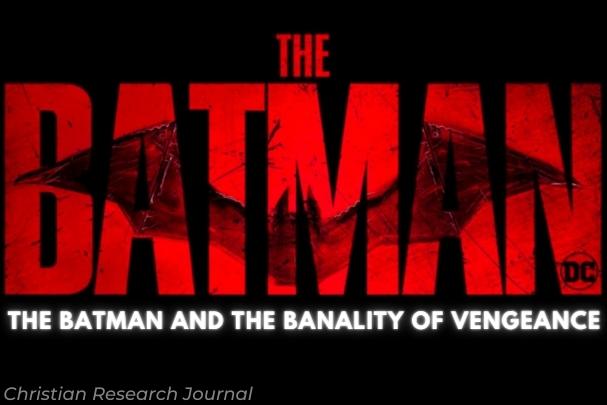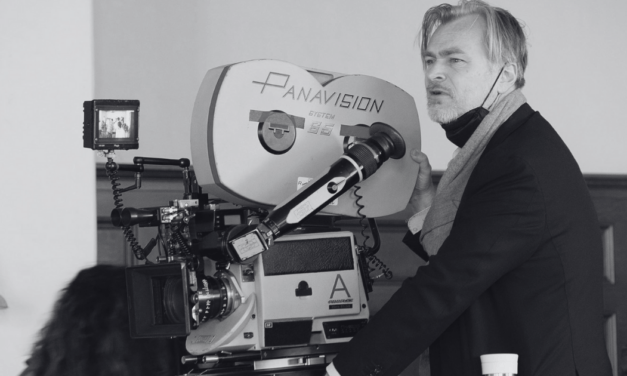The Batman
Directed by Matt Reeves
Written by Matt Reeves and Peter Craig
Warner Bros. Pictures
Rated PG–13
**Editor’s Note: This article contains spoilers for The Batman.**
This is an online-exclusive from the Christian Research Journal. For further information or to subscribe to the Christian Research Journal please click here.
When you to subscribe to the Journal, you join the team of print subscribers whose paid subscriptions help provide the resources at equip.org that minister to people worldwide. These resources include our ever growing database of over 1,500 articles, as well as our free Postmodern Realities podcast.
Another way you can support our online articles is by leaving us a tip. A tip is just a small amount, like $3, $5, or $10 which is the cost for some of a latte, lunch out, or coffee drink. To leave a tip, click here
In 2011, I was slowly but surely being rescued. Not from any one great and terrible thing, but from a thousand small and unsexy defects of character. That rescue came from a few predictable (but nonetheless important) sources: mentors, teachers, a very small pool of friends; all guided, of course, by the hand of the Divine. But perhaps the unlikeliest source came by way of Dewayne’s World, a comic book and tabletop game shop in Kingsport, Tennessee, where I picked up a comic with a haunting, inky silhouette stalking across the front cover: Detective Comics, issue #871. The original Batman title, and the first issue of Eisner Award-winner Scott Snyder’s renowned run writing the character.1 That comic — a dark, atmospheric, moody detective thriller — helped me to fall in love all over again with the comic book medium. Its twisted crime saga of fathers and sons became a mirror of sorts that helped me begin to work through the complexities of my own relationships with two very different but emotionally complicated parents.
Since that year, I have longed to see The Dark Knight Detective undergo a renaissance on the big screen. Sure, there has been a lot of Batman media in the last decade — from the conclusion of Christopher Nolan’s legendary trilogy to Ben Affleck’s brawny brawler interpretation, to the wildly successful Arkham video game series — but none of these entries have fully embraced Batman’s roots as a gritty, street-level crime solver. Especially over the last few years, as the spectacle of the comic book adaptation blossomed into a new phenomenon, the Batman who first appeared in Detective Comics #27 way back in May 1939 to solve the murder of a chemical industrialist, faded from public conscience. Well, under the stewardship of director Matt Reeves, that particular portrayal of Batman is making a comeback — and folks, it is glorious.
Batman Noir. In Matt Reeves’s The Batman,2 masked serial killer calling himself “The Riddler” (Paul Dano) has begun targeting Gotham City’s elites. He streams his misdeeds for a small cult of followers on the Internet and leaves a complex series of cryptic clues at the crime scenes to taunt the city’s resident vigilante, the controversial Batman (Robert Pattinson). Working alongside police lieutenant James Gordon (Jeffrey Wright), Batman launches an investigation to discover the Riddler’s identity, uncover his motivations, and stop him from killing again. But this investigation quickly leads Batman and his allies into the murky, swirling waters of Gotham’s criminal underworld, where the lines between hero and villain begin to blur. And before the Riddler’s crime spree is stopped, Batman finds himself at the epicenter of a complex mystery that reaches back decades and portends soul-shattering revelations for his alter ego, reclusive young billionaire Bruce Wayne.
To say that Reeves’s approach to the Batman character is scaled back would be an understatement, but this doesn’t come at the expense of audience expectations. The whole affair plays out across its walloping three-hour runtime like an acoustic cover of some of Batman’s greatest hits. The clever gadgets are present, but they’re not gimmicks; they are practical, accessible tools that make sense not only in the context of the narrative, but also in the context of the dirty, grimy version of Gotham City that Reeves has created, one rife with corruption and rotting from the inside. Even the iconic Batmobile makes an appearance in one of the movie’s most thrilling action sequences, but in Reeves’s capable hands it’s a rugged, applied, hand-built horsepower machine — when the engine thunders, the theater shakes. Part of what makes Reeves’s vision so compelling is the way he methodically reinvents these concepts that have become enmeshed in the popular imagination over the past century. This is undoubtedly and unashamedly a Batman film — for my money, the best adaptation yet — but it is Batman unlike we have ever seen him on the silver screen.
Yet audiences expecting a film that celebrates the character might find those expectations upended. Because as much as Reeves incorporates all the things audiences have come to love about the character, he turns right around and runs those expectations back at the viewer, interrogating the psychology of both Bruce Wayne and the audiences who adore him. In fact, by the time the credits roll, Reeves has so thoroughly cross-examined the filmic superhero genre that the jury is still out on whether this movie should even be considered a superhero film at all, and whether the genre will ever be the same in its wake.3
Dreams in Darkness. “I’m Vengeance” are the first words the Batman utters onscreen, and this is the best indicator for how Pattinson’s version of the character sees himself. In fact, most of the characters never refer to him as “Batman,” but by this moniker. These iconic words first entered the pop culture lexicon by way of Bruce Timm’s Emmy Award-winning 1990s cartoon, Batman: The Animated Series. In an early episode, to overcome irrational fears induced by a toxin, Batman (Kevin Conroy) rages to himself, “I am vengeance. I am the night. I am Batman!”4
This declaration, so cleverly inserted into the trailers for this film, are usually evoked in Batman media to prey upon the nostalgia of fans. But in Reeves’s film, the words become a brilliant starting point for his deconstruction of the character. If audiences are meant to clap their hands in shallow emotional rapture the first time Batman says them, then by the time one of the film’s villains utters the same words at the film’s end, the result is a staggering silence as the hollowness of the words become apparent (which is exactly what happened during my screening of the film) — not just to the viewer, but to the Batman as well. And this is the character arc that Reeves gives Bruce Wayne here, the realization that violence, retribution, vengeance are all banal, are not enough to truly heal the putrid, festering heart of Gotham City. In fact, if the Batman does not come to stand for something more than vengeance, then he is only perpetuating the endless cycle of violence corroding Gotham’s soul.
Make no mistake, this is exactly the kind of thoughtful commentary that Reeves struck out to provide. In an insightful interview with Time, he remarked that superhero movies “can be a reductive, iconic genre,” and that instead he “wanted to create a movie with shades of gray.”5 In this respect, he has succeeded. The Batman is the first adaptation to come along that dares to probe Bruce Wayne’s fractured psyche. It is not by coincidence or plot contrivance that Pattinson spends more time in the Batman suit than he does out of it. His version of Wayne is a man who has become a self-professed “nocturnal animal,” who has become so accustomed to the night that he cannot go outside in the daylight hours without sunglasses. The Batman persona is not heroic, but the very twisted and warped way that one man deals with his childhood trauma.
There is an episode of Batman: The Animated Series titled, “Dreams in Darkness,” wherein Batman is believed to have gone insane and becomes the latest addition to Arkham Asylum’s line of deranged inmates. Reeves’s film boldly asserts something quite like this premise: left unchecked, the Batman is just as psychologically damaged as the villains he stalks. The brief appearances of Alfred Pennyworth (a fully analog Andy Serkis) in this film serve to reinforce this point. Whereas Wayne’s iconic butler has almost always been portrayed as begrudgingly supportive of his ward’s nighttime escapades, here Alfred and Bruce are constantly at odds with one another. Alfred thinks Bruce has finally gone off the rails — and he’s right. The mending of this relationship becomes a major point in the film, one of the hinges upon which Bruce’s character arc turns as he comes to realize that he is, in fact, emotionally and psychologically crippled and that he doesn’t deal with trauma in healthy ways.
The Bat and the Cat. The other major character in the film who helps Wayne come to see his own damage is Selina Kyle (Zoë Kravitz). Here portrayed as a complicated, morally ambiguous femme fatale willing to cross lines that even the Batman will not, she nonetheless challenges Bruce’s black-and-white view of the world with motivations that become clearer as the film stretches on. At first appearing as someone that Batman happens across during his investigation, Selina is revealed to be intimately connected to Gotham’s criminal element by virtue of being the daughter of Carmine Falcone (John Turturro), the city’s biggest crime lord, and she has her own reasons for wanting to see him brought to heel.
Kravitz and Pattinson are electrifying when they’re together onscreen, their chemistry due to both actors being so committed to the darkness of their respective roles. Though the characters are combustible because of the messiness of their personal lives and maladjusted psyches, there nonetheless exists a degree of respect between them, because they are both dedicated to helping Gotham’s innocents.6 Their relationship weaves between allies and enemies, especially when Selina finally picks up a gun with the intention of doing what the Batman will not. And this interplay between competing ideologies concerning vengeance and justice is where the real stakes lie in this movie and demonstrates Reeves’s commitment to delivering a film that is as interested in thoughtful character development as it is major action set pieces — although the movie delivers on the action as well.
Despite being a long, lumbering dirge, The Batman is punctuated by moments of visceral, violent action that doesn’t skimp on cinematography at all. An entire essay could be written discussing the film’s symbolic use of its color palette. The practical effects work is top-notch too, making the sequence wherein the Batmobile speeds after a slippery Oswald Cobblepot (here played by an unrecognizable Colin Farrell), one of the most exhilarating car chases in recent memory. The big finale sees Batman single-handedly battling a cult of Riddler’s social media followers in the rafters above a jumbotron while Gotham City floods, and it is a spectacle of the highest order to behold. Michael Giacchino outdoes himself with his morose score, with jarring horns that come blaring in during the action sequences. All of it gels, even when the film begins to feel stretched, and the result is a movie that feels immaculately bespoke and hand-crafted. In the age of the corporate and self-conscious blockbuster, it is a minor miracle that a studio would allow a huge intellectual property such as Batman to be overtaken by such a singular creative vision and handled in such a way — a lesson that other studios would do well to note.
The Sins of the Father. Reeves’s subversion is made complete in how he intentionally muddies the waters surrounding the murders of Thomas and Martha Wayne. From the report of gunshots ringing in a dark alleyway to the scattering of Martha’s pearls upon grimy pavement, Batman’s origin has become one of pop culture’s most enduring modern myths. In the comics, the man who pulled the trigger has consistently been identified as Joe Chill, though his motivations have always been up for debate. Different Batman writers have posited different reasons, and Reeves contributes his own spin on the Wayne murders to bring his story firmly into a modern American context.
Though the exact circumstances surrounding their deaths are left vague, what is clear in Reeves’s vision is that Thomas Wayne (Luke Roberts), during his bid for mayor of Gotham, once turned to Carmine Falcone for help dealing with a journalist who threatened to reveal his wife Martha’s (Stella Stocker) history of mental illness. What Thomas never expected was that Falcone would have the journalist killed. After Thomas threatened to turn himself in to the police, he and his wife were gunned down. Bruce, now an adult, finds himself directly in the crosshairs of the Riddler, once a foundling in an orphanage run by Thomas and Martha and who now holds Bruce responsible for the failures of his parents. The Batman’s investigation into the Riddler uncovers this dark history of the Wayne family, forcing Bruce to confront his own twisted rationale for ever manifesting the Batman in the first place. The audience is thus forced to confront why they deify such a malformed and psychologically broken character.
Bruce must reckon with the fact that the Batman (“Vengeance,” as he calls himself) has become a kind of addiction — an analogy that Reeves himself uses to describe how he wrote the character. “And the truth is that he is a kind of drug addict,” Reeves said in an interview with Esquire. “His drug is his addiction to this drive for revenge.”7 And his supposed moral superiority — which comes from a position of wealth and privilege — has blinded him to the fact that even his own parents proved fallible under the right circumstances. Selina and the Riddler, both outcasts who have never had the luxuries of wealth, help to expose the flaws, but Reeves never positions them as being morally right either — this is a noir, after all, the film genre that excels in making the whitest of whites look a little gray. There are no “good guys” in film noir, and everyone in some way, shape, or form is morally compromised. “The protagonists of noir fiction, then,” writes crime novelist (and Christian) J. Mark Bertrand, “are not champions of moral order; if anything, they are its victims.”8
By the end of the movie, Gotham has been plunged into total chaos. The city is flooded, the newly elected mayor has been shot, and Bruce’s conception of his parents’ status as bastions of moral fortitude in a city gone to hell has been shattered. But in its final moments, the film rises above the noir genre to make a profound statement, one that moves it in the direction of the superhero movie. Batman emerges from the shadows to help rebuild the city. A film that begins with Batman stalking a gang of thugs and beating them to a bloody pulp ends with this same dark figure carrying an injured little girl to safety in the light of dawn. Bruce’s voiceover narration — a staple of the noir genre — explains that the Batman must become more than a symbol of vengeance and retribution if Gotham is to recover. He can no longer stand for revenge alone, but his true calling must instead be as a symbol of courage and hope. Very simply, the Batman must change.
To Shake Us Awake. The unfortunate reality is that, by and large, this is a film that will be ignored by most Christians due less to its content than its tone. Because the modern American church has become ensnared by the quaint but sinister trappings of sentimentality, which promise goodness without context, atonement without sacrifice. Books like Ecclesiastes or Proverbs have no place here, with their unflinching looks into the emptiness of the human condition, and therefore many in the church today talk a lot about being “saved,” without the ability to articulate what on earth they have been and are being saved from.
Films that lean heavily into the noir aesthetic, like The Batman, seem to exist to fill this void in the popular imagination. Despite “all the opiates, despite the shrill tinsel gaiety of ‘parties’ with no purpose, despite the grinning faces we all wear,” there can be no denying that something in this world is profoundly, disturbingly wrong.9 These movies exist to excavate the whitewashed tomb, to tear up the soil and reveal the dead, decaying form lying in the shallow grave as if to shake us awake. True goodness, these films remind us, is costly — a rare thing in a world ravaged by sin. Someone usually has to die, most often literally, other times they must die to themselves, as Bruce must learn to do throughout the course of this film. Indeed, the Christian apologist can lead someone to Jesus far easier talking about the bleak outlook of The Batman, where goodness is hard-won and costly, than many works of Christian media that have no conception of the pervasiveness of evil in the world.
With The Batman, Matt Reeves has fashioned a towering cinematic achievement that completely reinvents an iconic character by stripping him of that iconic status and taking him back to his comic book roots. Reeves delivers an extremely well-crafted film that draws more from classic crime thrillers than the superhero genre, proving that the Batman is just as relevant now as he was when he debuted almost a hundred years ago. By film’s end, the Batman comes to understand the importance of finding goodness in a world firmly in the filthy grip of sin. Bruce Wayne’s tortured soul has been scoured by the most ruthless brush — and so should ours. —Cole Burgett
Cole Burgett is a graduate of Dallas Theological Seminary and the Moody Bible Institute. He teaches classes in theology and Bible exposition and writes extensively about theology and popular culture.
NOTES
- This complete story arc became a #1 New York Times best-seller and was later published as Scott Snyder, Batman: The Black Mirror (Burbank: DC Comics, 2013).
- The Batman, directed by Matt Reeves, written by Matt Reeves and Peter Craig (Burbank: Warner Bros., 2022).
- David Ehrlich, “‘The Batman’ Review: The Future of Superhero Movies Is Finally Here, for Better or Worse,” IndieWire, February 28, 2022, https://www.indiewire.com/2022/02/the-batman-review-2022-1234702878/.
- Batman: The Animated Series, episode 3, “Nothing to Fear,” directed by Boyd Kirkland, aired September 15, 1992, on Fox Kids, https://www.imdb.com/title/tt0519606/.
- Matt Reeves, quoted in Eliana Dockterman, “The New Batman Is Deeply Unsettling. The Director Says That’s the Point,” Time, February 28, 2022, https://time.com/6151836/batman-matt-reeves/.
- Video interview with Zoë Kravitz in Corey Chichizola, “The Batman: Zoë Kravitz Opens Up about Catwoman’s Tie to the Robert Pattinson Hero,” Cinemablend, May 5, 2021, https://www.cinemablend.com/news/2566953/the-batman-zoe-kravitz-catwomans-robert-pattinson-hero.
- Matt Reeves quoted in Johnny Davis, “Director Matt Reeves Says ‘The Batman’ Is Inspired by 1970s Cinema, 1980s Comic Books and…Nirvana,” Esquire, January 25, 2022, https://www.esquire.com/uk/culture/a38791912/matt-reeves-interview-the-batman/.
- J. Mark Bertrand, “Writing about Reprobation,” byFaith, April 28, 2011, https://byfaithonline.com/writing-about-reprobation-2/.
- Sylvia Plath, from The Unabridged Journals of Sylvia Plath, ed. Karen V. Kukil (New York City: Anchor, 2000), 31.









